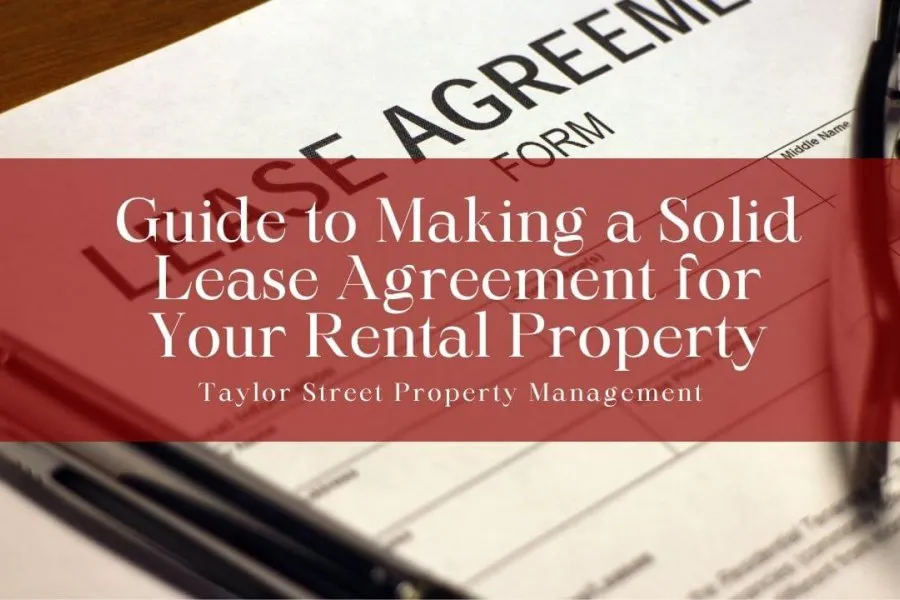A lease agreement establishes and binds the relationship between a landlord and tenant. The agreement is a legal document that explicitly describes the responsibilities of both the landlord and tenant.
A solid lease or rental agreement acts as a guide, offering counsel and direction during tough situations. It provides information on rent collection, enforcement of penalties and fines, and also on property management issues.
This article will provide a guide to landlords to help them craft a solid lease agreement.
The Importance of a Lease Agreement
While a detailed lease agreement has many advantages, one key benefit supersedes all. A solid lease agreement protects a landlord from potential financial hazards.
Every landlord will have their reasons for choosing to invest in real estate. With a detailed lease agreement, you will be able to protect your investment property from potential financial pitfalls.
The lease agreement should explicitly describe the expectations you have for your renters in terms of rental payments, property maintenance, and the lease period. Such thoroughness protects you from problematic tenants.
The Components of a Lease Agreement
Most lease agreements adhere to a standard format. Some of the key components of a lease agreement are detailed below:
The Term of the Lease
This refers to the period that you have agreed to lease the space or property to the tenant. You may choose to have the orthodox long-term lease or a month-to-month lease. Each type of lease has its benefits and drawbacks.

If you are unsure of the qualities of the tenant, you can choose to offer a month-to-month lease as you get to know them better. Once they have proven themselves to be a quality tenant, you can offer a long-term lease.
Security Deposit
Also referred to as a damage deposit in other circles, it’s a sum of money given to the tenant at the commencement of the lease. The deposit serves as insurance in case of any damage to the rental unit that goes beyond normal wear and tear during the lease term.
The security deposit is usually returned to the tenant in part or full after an inspection of the property is done. In case of repairs, the landlord must provide receipts and other documents justifying any deductions made to the security deposit. The lease agreement must be clear on the form where the tenant will receive the security deposit balance.
What’s more, the amount you charge as a security deposit is usually stipulated by law. It’s therefore important that you read the state’s Landlord-Tenant Laws as they pertain to security deposits.
Repairs and Maintenance
It’s the responsibility of the landlord to keep the property in a safe and habitable condition. Landlords are responsible for the repair of plumbing, heat, the air conditioning, among other systems.

As the landlord, you must also ensure that you respond to the tenant’s maintenance requests promptly. You will therefore want to outline the tenant’s responsibility to notify you when repairs are needed.
The lease agreement should stipulate the property maintenance process. The lease should also clearly state the timeframes for the repair of different elements. For example, the landlord agrees to repair electrical faults within one day.
Rent Reviews and Increases
Rent increases and reviews serve an important role. First, they act as a hedge against high inflation levels. Furthermore, they adjust the rental price of your property, taking into account the demand for housing and the current market.
The lease agreement must specify the amount or percentage that rent will rise. You must also ensure that you’re always following state rent increase laws. These regulations are subject to change therefore you should always double-check before following through on an increase.
Note that if you are considering using short-term leases, rent reviews are not common. In practice, rent reviews are done every three to five years.
The Termination of the Lease
The lease agreement must be clear on the options available come to the end of the lease. Does the tenant have the option to extend, or are they expected to vacate the premises? The lease should also be clear on how much advance notice is required when looking to vacate the premises.

As stipulated earlier, the lease agreement contains obligations and responsibilities that the tenant must meet as well. Any breach of the contract is grounds for termination. The lease agreement must describe what will occur if the tenant must leave the premises before the expiry of the lease.
It should be noted that there are certain reasons for termination that are allowable under Arizona law (https://www.azleg.gov/). For example, if the tenant has active military duty, experiences landlord harassment, or is a victim of domestic violence.
Utilities
Utilities can contribute to a significant portion of the monthly rent or expenses. This includes gas, heating, plumbing, and other appliances. The lease agreement should indicate from the get-go who’s responsible for paying for the utilities.
Conclusion
From the information detailed above, one cannot deny the impact of a detailed and solid lease agreement on the landlord-tenant relationship. It can be used to prevent and/ or solve conflicts as well as protect your real estate investment. As a landlord, it’s best to engage the services of an experienced property management professional to ensure a smooth tenancy.
Taylor Street Property Management is a locally owned and operated property management company based in Phoenix, Arizona. We offer quality and customized services to rental property owners in Phoenix, Scottsdale, Chandler, Gilbert, Peoria, Mesa, Tempe, and Paradise Valley.
Contact us today via phone or email to get more information on our property management services!


